via wired.com
With Comic-Con came more information and more visuals from the highly anticipated Disney movie Tron: Legacy. It’s the sequel to the 1982 movie Tron, an anthropomorphic view of what life would be like inside a computer if softwear were people-like and not just electronic bits.
The original movie had a message, but perhaps best known for its exciting (in 1982) sci-fi visual effects and images. The sequel had to live up to having an up-to-date, 2010 version of the best in distinctive electronic imagery, and so far it looks like it may have succeeded.
The 1982 film had a story that was concerned with warning about computers knowing too much about us and controlling our lives. Now we accept that as just the way it is, so the new movie had too look for modern concerns for its storyline. About the new message, the writer/director said, “Technology is all about bringing people together, supposedly, and now there’s this sense that technology may have a dark side that keeps us from connecting with each other, and I think this film examines that problem.”
The first movie used scenes of video game action within the computer as a showcase for the imagery. In the new movie, combatants once again fight it out in the virtual world, hurling discs and riding light cycles. They also still wear suits that have the movie’s trademark glow, expect in the modern version. costumes shine more brightly, due to electroluminescent lamps woven into the casts’ tight-fitting suits. Before “action!” was said on set for each scene, there would be a call to “light ‘em up!” To make the new movie even more visually stunning, it was filmed in 3-D rather than having it added post-production.
Actor Jeff Bridges stars in Tron: Legacy, reprising the role of videogame designer Kevin Flynn. Between the time of the first and second films, it is revealed that the character has been lost in the network for many years. His son, played by Garrett Hedlund, enters cyberspace to look for him. There are again life-and-death battles between the inner world characters, played out in the dark, foreboding, but shiny environment that most of the movie takes place in.
The original movie grossed only $33 million in the United States in 1982. Expect the sequel to do much better.
Wednesday, July 28, 2010
Tuesday, July 27, 2010
Raspberry Brie Panini
 I love panini. There’s something wonderful in how a plain meat and cheese sandwich can be transformed into a deliciously satisfying experience. I don’t how it happens, but the pressing of the bread, the oozing of the melted cheese, and the mixture of other stuffings all combine to make a special treat that makes my mouth and tummy quite satisfied.
I love panini. There’s something wonderful in how a plain meat and cheese sandwich can be transformed into a deliciously satisfying experience. I don’t how it happens, but the pressing of the bread, the oozing of the melted cheese, and the mixture of other stuffings all combine to make a special treat that makes my mouth and tummy quite satisfied.I see this recipe for a raspberry and brie panini and I don’t know if I would find it as satisfying as a meat based sandwich, but it sure is pretty to look at. I want to try one.
I don’t cook, although I do have an unopened panini grill that I received as a present last Christmas. Actually, I had forgotten about it until I started writing this note.
Now I’ve gotten myself so worked up thinking about my love of panini, I want to unbox it tomorrow and give the little appliance a try. It won’t be raspberry and brie, but I may be able to able to cobble together some fat-free swiss cheese, fat-free hot dogs, and the ends of the loaf of bread that I haven’t thrown out yet.
The ingredients don’t matter. The panini process makes anything remarkable. (Or at least, we’ll see.)
The Italian word panino refers to a small bread roll. It is the diminutive form of pane (“bread”). The plural is panini, which when you have it, linguistically justifies eating more than one.
photo and recipe via rockrecipes.blogspot.com
Saturday, July 24, 2010
Flexibility
via godsnmonsters.tumblr.com

With that kind of limberness and that package, why is he bending backwards?

With that kind of limberness and that package, why is he bending backwards?
History of Alphonse Maria Mucha
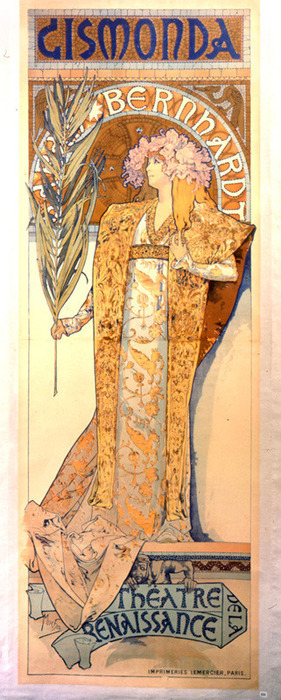
July 24th, 2010, is the 150th anniversary of the birth of the renown Czech artist Alphonse Maria Mucha. Mucha is known for his works in several mediums in the Art Nouveau style, which he helped to popularize around the end of the 19th century.
The work that first brought him fame was a poster of the actress Sarah Bernhardt for the play Gismonda (seen here). Its creation story is that on Christmas Eve, 1894, Mucha was doing a favor for a friend, a printer, correcting proofs. On that day Bernhardt contacted the printer with a request for a new poster for her play, which she needed as soon as possible. All the printer’s artists were on holiday, so Mucha volunteered to create the poster. Bernhardt was the queen of celebrities in her day and her wishes were quickly addressed.
The resulting poster, which Mucha created in two weeks, was an instant success and revolutionized poster design. The long narrow shape, the subtle pastel colors and the stillness of the near lifesize figure introduced a look that was quite novel for the time. The poster was so popular with the Parisian public that collectors were known to bribe the laborers who hung them to hand them over, or simply to go use razors to cut them down from the walls. Bernhardt was so satisfied with the poster she gave Mucha a muli-year contract to produce stage and costume designs as well as posters for her.
After that, his posters, panneaux decoratifs, calendars, prints, magazine and book illustrations attained enormous popularity. With his exquisite decorative motifs, abundance of ornamental pictorial elements, and beautifully graceful lines, his compositions shaped the the Art Nouveau style.
The “le style Mucha” became the pattern for a whole generation of graphic artists and draftsmen.
His hallmark was the idealized, stylized figure of a graceful woman, loosely but inseparably framed in an ornamental system of flowers and foliage, symbols and arabesques. As this was one of the most widespread pictorial motifs of the turn of the century, the Mucha Style became for a while to be regarded as synonymous with the whole Art Nouveau movement.
Mucha actually disliked the name “Art Nouveau”, or the idea that it was a movement, arguing that art was eternal and therefore could not be “noveau.” He insisted he derived his main inspiration from Czech artistic traditions, rather than subscribing to the doctrines of any particular school.
A hundred years later, Art Nouveau is still a wonderful visual stimulation.
Labels:
art,
Art Nouveau,
Czech,
Mucha
Monday, July 19, 2010
A New Caravaggio Painting Found?

On the coincidental 400th anniversary of artist Caravaggio’s death, the Vatican’s newspaper published a story that a previously unknown painting by Caravaggio had been discovered. It had been in the possession of the Society of Jesuits in Rome.
The subject of the painting is a semi-naked St. Lawrence. The saint was grilled to death in 258 AD, and accordingly the painting shows Lawrence over the flames. According to legend, during his torture Lawrence cried out “This side’s done, turn me over and have a bite.” (Assum est, inquit, versa et manduca.”) This is why Lawrence is the patron saint of comedians, butchers and roasters.
Stylistically, the painting is similar to the works of Caravaggio (real name Michelangelo Merisi), but that’s not conclusive. A lot of art students created works in the style of whomever they admired.
Thomas Eakins’ The Gross Clinic Back On View
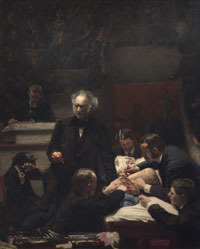
After a year of conservation and restoration work, Thomas Eakins’ painting Portrait of Dr. Samuel D. Gross (The Gross Clinic) is going back on view at the Philadelphia Museum of Art. The painting is considered to be the greatest American painting of the 19th century.
Because of the work done on it to remove and fix problems caused by age and past restoration and conservation work, the painting is going to look different from how you saw it before, either in person, or in any art text book you ever had. It’s intended to look now more like how the artist painted it.
This painting was the object of an expensive battle to keep it in its native Philadelphia. When the previous owner, Thomas Jefferson University, decided to sell it, it made the deal with the National Gallery of Art and the Crystal Bridges Museum of American Art in Bentonville, Arkansas. The painting would leave its home city and move to rural Arkansas. The $68 million purchase, a record for pre-WWII American painting, was being funded with the assistance of Alice Walton (of the Wal-Mart Waltons). Fortunately, the Thomas Jefferson University agreed to sell it instead to the Philadelphia Museum of Art and the Pennsylvania Academy of Fine Arts if they could match the price. They agreed and the painting stayed in Philadelphia.
Russian Billionaire Boosts $2 Billion Faberge Collection
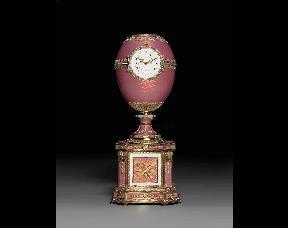
Russian billionaire Alexander Ivanov says he has spent 90 million euros ($107.8 million) in the last year to add 100 additional items to a collection of 3000 Faberge items he says are worth $2 billion.
It is surprising that there could be that many items in total in the world, let alone in one person’s collection.
Ivanov shows his collection in his own museum that he has in the German spa town of Baden Baden. He chose that location because it has 8 million visitors a year and historically has been popular with the Russian well-to-do. In the 19th century, prominent visitors included writer Fyodor Dostoyevsky and members of the Russian royal family. Ivanov plans to open a second museum in the Croatian city of Dubrovnik, another popular European tourist spot.
Ivanov’s biggest purchase was the 1902 Faberge egg made as an engagement gift for Baron Edouard de Rothschild. Ivanov bought it in 2007 for $18.5 million, and says it’s Faberge’s “finest ever.” The gold and pink enamel egg has a clock and a diamond-set cockerel that pops up every hour and flaps its wings (see photo above).
Ivanov’s latest purchases include a 27-inch high silver clock given to Russian Emperor Alexander III and his wife by relatives in 1891 for their 25th wedding anniversary. He wouldn’t say how much he paid.
Faberge pieces prove that a thing of beauty is a joy forever.
Sunday, July 18, 2010
Ryan Reynolds’ Green Lantern Suit Is Painted On
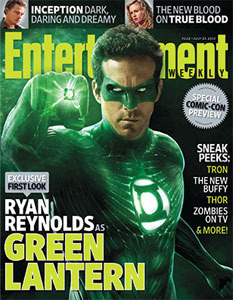
To me, most movies based on comic book superheroes are a major miss. They focus on a lot of special effect shots and spend little on the character development and plot that might make the films interesting.
Sometimes the actors can make all the difference as to whether the movie is worth seeing or not. For example, Brandon Routh as Superman and Chris Evans as the Human Torch made their films worth spending the money to rent them.
The upcoming movie about Green Lantern might be worth seeing for the sake of the star, Ryan Reynolds. I’ve liked him going back to when he was on Two Guys, A Girl, And A Pizza Place. He’s got the talent to turn even a farce like Van Wilder into an entertaining movie.
It’s been revealed that the suit he “wears” in Green Lantern is actually digitally painted on, using a motion capture suit (covered with computer sensors) and CGI to add the GL suit later. It’s said that the suit “hugs his every muscular ripple. Little is left to the imagination.” This might make the movie something to see just for this reason, as Reynolds is known to be well-developed.
Because it’s a special effect, the muscle definition will probably be digitally enhanced, covering the real Ryan. It would have been better to paint him all over with liquid latex. I’d pay the theater ticket price just to see that on a big screen (especially if it were 3-D!).
Chace Crawford Makes His Assistant Wet

Is this for real? Chace Crawford is shown above supposedly with a personal assistant holding his Pride umbrella for him as he walks down the street. It doesn’t seem possible that someone would be so arrogant as to have someone else do this for them, when they have nothing but their cap in their hands and could hold the umbrella themselves.
It shows how PAs are psychotic. How could you have so little self-esteem that you would agree to do this? I would tell CC to go f*** himself with it and appropriately enjoy all the colors of the rainbow.
House slaves had to do this kind of thing because they would be punished if they didn’t. PAs do it because they want to. Sick.
On the other hand, if Chace likewise wants assistance so that he can use the urinal but have someone else hold it, I am so there.
Jeffery & Cole Casserole Gone Bad
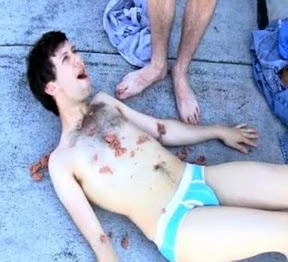 via trickwire.wordpress.com
via trickwire.wordpress.com The gay comedy team of Jeffery Self and Cole Escola are back on LogoTV for their 2nd season of their comedy sketch show Jeffery & Cole Casserole. While the 1st season of Jeffery & Cole Casserole was a hilarious helping of absurdity, the 2nd season appears to be only a caricature of the first. The entertaining quality of a show about two guys doing amateur videos now looks like just two guys doing an amateur video. It’s sad to see something good go downhill so fast.
There is a rumor that Logo paid Self and Escola a very small sum of money for their work. Perhaps for the second season, the pair decided to give the company what it paid for, and intentionally decided to deliver a load of crap. It doesn’t help the viewer if that were true, but at least it would make the two of them not look so tapped out.
Friday, July 16, 2010
James Wolk

via trickguys.com
Finally! James Wolk is coming back to TV. He was first noticed in the Hallmark Hall of Fame presentation of Front of the Class in 2008. His superb acting ability, cuteness, and beefy body gave viewers both an emotional and physical woody. He definitely left people wanting more, but he came out of nowhere, made a splash and then wasn’t seen anywhere else. So it’s about time he was back on TV getting people sweatingly excited.
Wolk will star in Fox’s new show Lone Star, which debuts in Fall, 2010. The trailer is out and it can be seen that Fox is intent on promoting all of Wolk’s assets. Sizzling.
Village People Upset About YMCA Name Change
via advocate.com
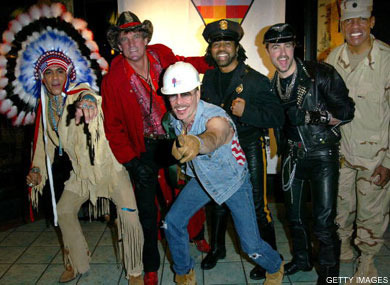
On July 12th, the organization known as the Young Men’s Christian Association, or YMCA, announced that it would shorten it’s name to just “Y”. Most people have probably been calling it that for a long time, so the name change shouldn’t have much effect on its patrons. However, one set of people who have a stake in what the organization is called is the long-lived Village People. Their song “YMCA” has sold more than 15 million units and is the group’s best selling single. Due to its never-ending popularity at sporting and other events, it’s the song that keeps the group alive and viable.
The group says they will of course continue to sing the song with all four letters intact. Perhaps they should instead repeat the initial letter for all four notes, but with the last three meaning “why, why, why”, as in, why don’t straight people understand even 30 years later that they are singing about and celebrating having gay and/or male-male bathhouse-like sex at the YMCA? Someone should teach them to do more appropriate positions during the song rather than forming letters. Replace the M, C, & A arm motions with the bend-over, the crouch down, and the leg lift.

On July 12th, the organization known as the Young Men’s Christian Association, or YMCA, announced that it would shorten it’s name to just “Y”. Most people have probably been calling it that for a long time, so the name change shouldn’t have much effect on its patrons. However, one set of people who have a stake in what the organization is called is the long-lived Village People. Their song “YMCA” has sold more than 15 million units and is the group’s best selling single. Due to its never-ending popularity at sporting and other events, it’s the song that keeps the group alive and viable.
The group says they will of course continue to sing the song with all four letters intact. Perhaps they should instead repeat the initial letter for all four notes, but with the last three meaning “why, why, why”, as in, why don’t straight people understand even 30 years later that they are singing about and celebrating having gay and/or male-male bathhouse-like sex at the YMCA? Someone should teach them to do more appropriate positions during the song rather than forming letters. Replace the M, C, & A arm motions with the bend-over, the crouch down, and the leg lift.
Thursday, July 15, 2010
Jon Benet Memorial Beauty Set
If I were a child receiving this, I'd use the mirror to keep one eye looking behind me for any family members who might wander into my room. Just saying.
Wednesday, July 14, 2010
Which German Soccer Player Is Gay?
The German gay web site Queer.de took a poll of its readers to find out which German soccer player would be the least surprise if he came out. As of the writing of this post, Arne Friedrich had the most votes followed by Philipp Lahm, who just got married after the end of the World Cup. I would take Lahm or Podoloski into the fold anyday, but it doesn’t look like Lahm fits the bill. Are there gay German soccer players?
B) 128 votes, 7.1%: Mirolsav Klose
C) 405 votes, 22.4%: Philipp Lahm
D) 70 votes, 3.9%: Thomas Müller
E) 328 votes, 18.2%: Manuel Neuer
F) 126 votes, 7.0%: Mesut Özil
G) 187 vote, 10.4%: Lukas Podolski
H) 136 votes, 7.5%: Outings impossible - the guys are just too diverse
All football players say they are straight - if it would be different, whose outing would surprise you the least?
A) 425 votes, 2 3.5%: Arne Friedrich
B) 128 votes, 7.1%: Mirolsav Klose
C) 405 votes, 22.4%: Philipp Lahm
D) 70 votes, 3.9%: Thomas Müller
E) 328 votes, 18.2%: Manuel Neuer
F) 126 votes, 7.0%: Mesut Özil
G) 187 vote, 10.4%: Lukas Podolski
H) 136 votes, 7.5%: Outings impossible - the guys are just too diverse




